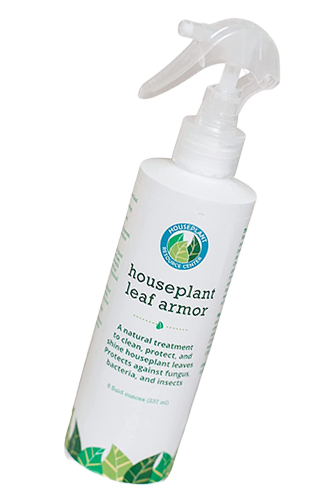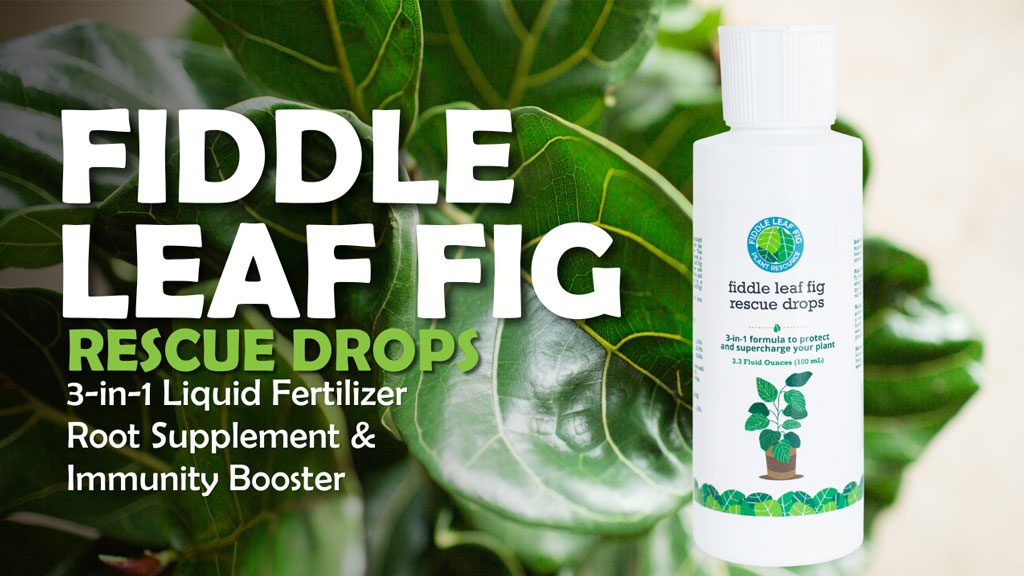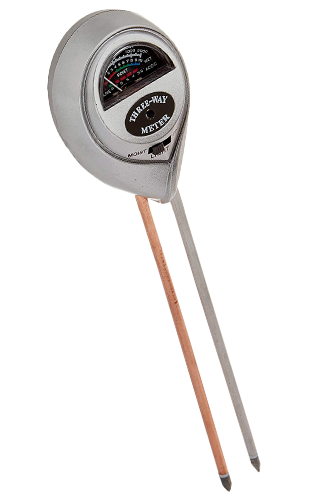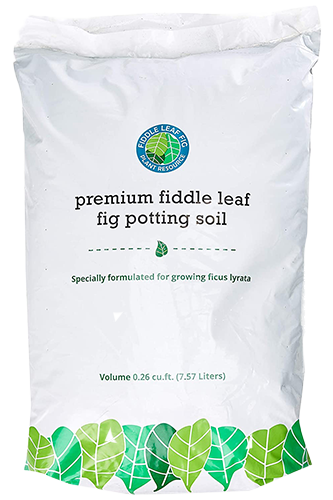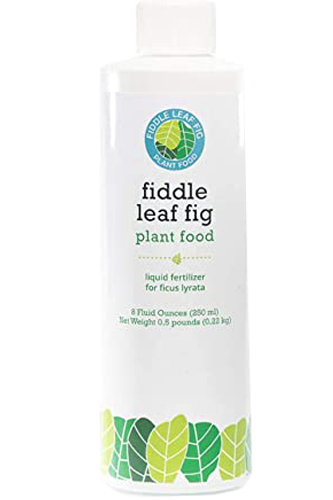Like all organisms, fiddle leaf figs can get sick! Despite your careful and consistent care routine, you might run into one or more of these common fiddle leaf fig diseases and conditions at some point. It’s important to recognize them and know how to treat them!
Some of these diseases are more common than others, so we’ll start with the most common first and work our way down to the least common. Recognizing early signs of fiddle leaf fig diseases is essential for prompt intervention.
Common Fiddle Leaf Fig Diseases

#1: Edema
While this is technically not a disease, it’s a condition that troubles many fiddle leaf fig owners.
Edema occurs when a fiddle leaf fig is slightly overwatered or receives very inconsistent watering. This may cause cells in the leaves to burst, which shows up as tiny red or brown dots all over your new growth.
While mild cases of edema are harmless, severe cases can indicate a major issue with your watering routine. If all of your new leaves are covered in small red dots that linger as the leaves grow, it’s time to tighten up your watering.
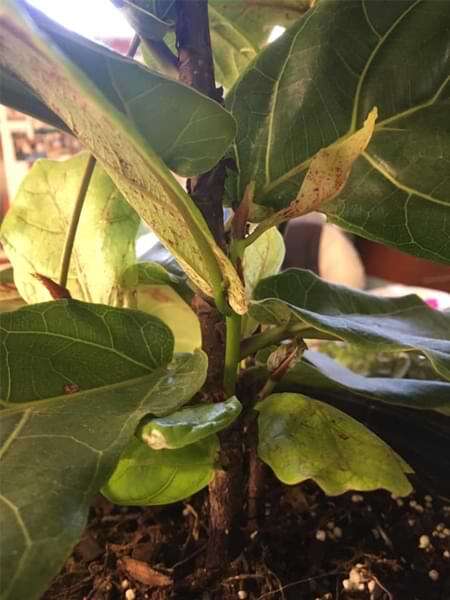
Note: Similar red dots can also be caused by spider mites, so it’s worth it to inspect your plant for these pests as well.
How to Treat:
The best way to water your fiddle properly is to learn to take cues from your plant to know when it needs a drink.
I strongly recommend using a moisture meter so you can gauge what’s going on in the root ball. Many people rely on the finger test to feel whether the top few inches of soil are dry, but depending on the aeration of your soil, the top of the soil might be bone-dry while the root ball is still soaking wet!
Here’s how to use a moisture meter to water your fiddle more consistently.
There are also many factors that might affect a fiddle leaf fig’s watering needs, so make sure to familiarize yourself with those so you can provide the best possible care. Read on for more information on fiddle leaf fig diseases to promote a thriving indoor garden.
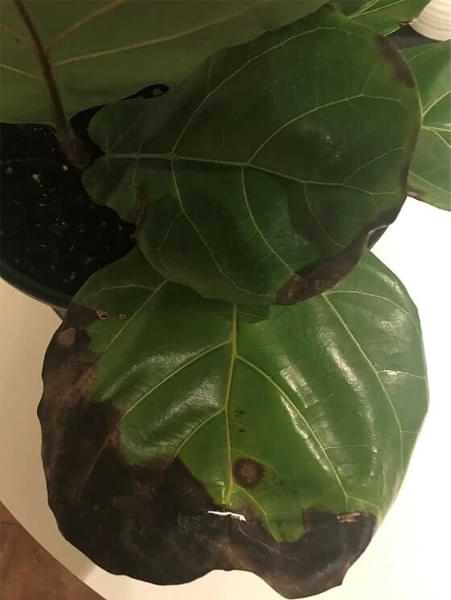
#2: Root Rot
Root rot is a fungal infection in the roots of a plant that often occurs when the soil is too wet for too long, which allows fungus to grow.
When your fiddle leaf fig has root rot, you’ll notice dark brown or black spots appearing on the bottom leaves first and working their way up the tree. You might also notice browning or blackening veins on the lower leaves, mushy stems, and a funky smell coming from the soil.
If you pull the tree out of the pot, you might also notice mushy black roots that have begun to rot away.
How to Treat:
If you notice these symptoms, it’s important to act right away.
If the symptoms are mild and you only see a spot or two and there is no odor, you might be able to remove the damaged leaves, ease up on the water, give your tree more light, and use our Root Supplement to prevent further infection and help the roots heal.
If the symptoms are more severe and the spots are spreading, it’s time to repot your tree.
Carefully remove your fiddle from the pot and get as much of the old soil off the root ball as possible. Be sure to trim away any rotting roots!
Repot the tree into fresh, fast-draining soil and a clean pot with drainage holes. Place the tree in a spot where it will get plenty of bright, indirect sunlight (this will help the tree heal and prevent the root rot from returning). You may also want to remove the affected leaves, but don’t take more than 10% of the leaves in any given week.
Give the tree a little less water than normal and hold off on fertilizing for a month or so after repotting. I recommend using our Root Supplement to help the roots recover and prevent the infection from returning. Continue reading about fiddle leaf fig diseases to help your fiddle leaf fig plant.
#3: Bacterial Infection
Luckily, this disease isn’t super common, but it can wipe out your plant in a hurry if you don’t treat it right away.
Bacterial infection can be difficult to tell from root rot. Whereas root rot usually shows up as dark-brown spots on the lower leaves, bacterial infection appears all over the tree, manifesting in medium-brown spots (sometimes more than one on a single leaf), often ringed by slight yellowing.
The causes and treatment of bacterial infection is the same as that for root rot, so it’s okay if you can’t quite tell the difference.
How to Treat:
If you notice a lot of brown spots on your tree, carefully remove those leaves with clean hands and tools, and repot the tree into fresh soil and a clean pot with drainage.
Provide plenty of light and give your tree a little less water than usual, and use our Root Supplement to help your tree recover.

#4: Powdery Mildew
This is a fiddle leaf fig disease caused by poor air circulation between the leaves. If your tree is affected, you’ll notice chalky white or gray spots on your stems and leaves that come off when you rub them.
Powdery mildew can make your fiddle more vulnerable to insects and eventually kill your tree. It can also spread to other houseplants, so make sure to act fast!
How to Treat:
The first thing to do is isolate your fiddle so the fiddle leaf fig disease fungus doesn’t spread to other plants.
Since this disease is caused by stagnant air and damp, dark conditions that allow fungus to grow, you want to create the opposite. To increase airflow between the leaves, open some windows or doors and turn on a fan to create air movement in the room (but don’t point it directly at your fiddle).
If you only see spots on a few leaves, use sharp, clean shears to remove those leaves. Be sure to clean the shears between cuts, and don’t touch any of the healthy leaves and potentially spread the fungus.
The next step is to protect the remaining leaves. Use our Leaf Armor to treat the leaves, or mix 1 teaspoon baking soda into 1 quart of water and spray both sides of your leaves generously.
Avoid misting your tree for now, and make sure to provide plenty of bright, indirect sunlight to discourage fungal growth.
Prevention Is Always Best
This probably goes without saying, but we cannot oversell the power of a consistent care routine for fiddle leaf figs. Lots of bright, indirect sunlight, consistent (and appropriate) watering, proper humidity, drainage, and the right fertilizer will go a LONG way in keeping your tree healthy! Understanding common fiddle leaf fig diseases is crucial for maintaining the health of your plant.
Check out these resources for taking the best possible care of your fiddle leaf fig:
The Fiddle Leaf Fig Expert Book


